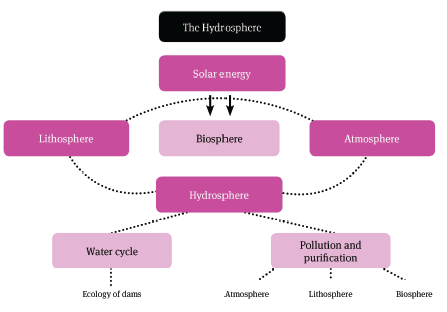Chemical Systems - Physical Science Grade 10 Study Guide
Share via Whatsapp Join our WhatsApp Group Join our Telegram GroupOverview

Summary
1 Interconnected systems
1.1 Interconnected systems and the water cycle
- There are four interconnected systems that make life on Earth possible. These are:
- atmosphere – the layer of gas surrounding the Earth, mostly nitrogen, oxygen and carbon dioxide
- lithosphere – the solid, outermost part of the Earth’s crust
- hydrosphere – all the Earth’s water
- biosphere – all living things (plants and animals) on Earth.
- Water moves through these spheres, dissolving chemicals and promoting growth of plants and animals. It also has the effect of moderating the temperature of the Earth – not allowing it to get too hot during the day or too cold during the night.
- The water cycle describes the changes water undergoes as it circulates through the different spheres. Important processes in the cycle are:
- evaporation – liquid water turns to water vapour
- precipitation – the condensation of water vapour to form liquid water (rain, dew)
- interception – the taking up of water by plants and animals
- transpiration – the giving off of water through the leaves of plants
- infiltration – the trickle down of water into the lithosphere to form ground water.
1.2 Pollution and purification
While water dissolves beneficial nutrients that are taken up by plants and animals, it also dissolves chemicals that are harmful.
- In the atmosphere, carbon dioxide and the oxides of sulphur and nitrogen are gases emitted by the burning of fossil fuels that pollute the atmosphere. They dissolve in the water vapour, resulting in acid rain.
- In the lithosphere, water dissolves fertilisers and pesticides, which pollute rivers and ground water. These can promote abnormal plant growth in rivers and dams, causing the depletion of oxygen. This can cause aquatic animals and organisms to die.
- In the biosphere, water can carry harmful bacteria from decaying and infected plants and animals into ground water. This can cause sickness in animals and humans.
Water can be purified by physical means (filtration), biological means (bacteria that remove waste products) and chemical means (mainly chlorination).
1.3 The ecology of dams
Dams are constructions that limit the flow of water in a river or stream. They are beneficial in providing water during drought and limiting flooding during heavy rain. They can provide hydro-electricity and boating and other leisure activities.
However, they also have an adverse effect on the ecology of the surrounding areas. Large areas are flooded, humans and animals are displaced and there is less provision of water downstream of the dam. Engineers have to strike a balance between environmental concerns, sustainability and economic and agricultural needs.